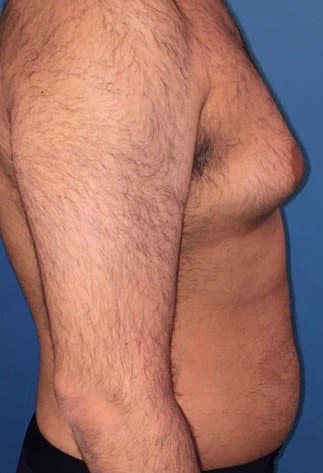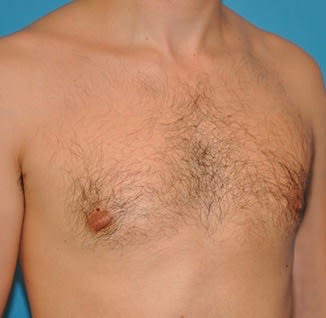
The Skinny
Overview
Gynecomastia is a medical condition that is colloquially called “man boobs” or “moobs”. It refers to breast growth in men. Common signs of gynecomastia include puffy nipples, enlarged glandular tissue, and excess skin and/or fat tissue in the chest area. There is a wide range of possible appearances, from pointed nipples to very feminized breasts that droop down toward the navel.
This article explores the different grades of gynecomastia and the surgical techniques used to correct it. Some pros and cons of male breast reduction surgery, ideal candidates, before and aftercare tips, and safety concerns are also reviewed.
AEDIT
Before & After Images by Provider












Before & After Images by Provider
Male Breast Reduction (Gynecomastia Surgery) Solutions
The Specifics
Grades & Causes of Gynecomastia
Gynecomastia presents in a range of appearances that are graded from I-IV as follows:
Grade I: Mildly excessive fat and/or glandular tissue with no excess skin; puffy nipples; Grade II: Moderate amount of excess fat and glandular breast tissue with no excess skin or sagging; Grade III: Moderately excessive glandular tissue and fatty tissue, mild-to-moderate excess skin and mild sagging; Grade IV: Severely excessive fat and glandular tissue, severe excess skin, female breast shape, and very low-drooping breasts;
Gynecomastia is quite common. Possible causes include genetic predisposition, hormonal imbalance (excessive estrogen), chronic obesity, and use of various drugs, including some anabolic steroids. The Mayo Clinic reports that it affects more than 50% of male infants (due to estrogen from the mother), and at least 1 in 4 men between the ages of 50-69 years. Men with enlarged breast tissue may feel very self-conscious about the condition. It often affects self-confidence, socialization, intimate relationships, and overall contentedness.
Goal of Gynecomastia Surgery
The goal of male breast reduction surgery is to create a more masculine chest appearance in men with feminized breasts. Sometimes, gynecomastia goes away on its own. However, many cases require surgical intervention which typically includes liposuction, glandular and fat tissue excision, or a combination of the two.
Pros & Cons of the Procedure
The American Society for Aesthetic Plastic Surgery (ASAPS) asserts the advantages of gynecomastia surgery as:
There are not a lot of negatives associated with gynecomastia surgery. In most cases, patients are happy with the results. ASAPS reports a 93.2% patient satisfaction rate. There is some scarring that results, which causes some men to feel self-conscious when undressed. However, scar revision procedures and laser resurfacing treatments can reduce the appearance of prominent scars.
Ideal Candidate
According to the American Society of Plastic Surgeons (ASPS), good candidates for male breast reduction surgery include men who desire more attractive chest contours and:
The best candidates for gynecomastia surgery have realistic expectations about it and its possible results. Discuss your specific goals with a board-certified plastic surgeon who specializes in male breast reduction and other similar body contouring procedures.
Before & Aftercare
Take your time choosing your surgeon as this important decision will affect the aesthetic results you will achieve. If you are a good candidate and decide to have gynecomastia surgery, then your journey will begin with an initial consultation appointment with the surgeon you choose to work with.
Use this meeting to discuss your questions and concerns about the surgery one-on-one with your doctor. Make sure that you understand the details of the surgery, the results that are possible, and what your options are if the results are not as expected.
The surgeon will examine your chest to assess breast size and shape. Nipple size and position, areola diameter, skin elasticity, and other relevant variables will be noted. Confidential pictures will be taken for the doctor to use during preoperative planning, and for before and after comparisons.
If no additional testing is necessary, the cosmetic procedure will be scheduled. Grade I gynecomastia surgery can typically be performed using a local anesthesia agent and/or intravenous sedative drugs. Grades II-IV normally requires the use of general anesthesia to achieve total unconsciousness for the patient during the surgery.
After the removal of excess breast tissue has been completed, the small incision sites are closed with dissolvable sutures, and then, covered with a coating of surgical glue that forms a sterile barrier against pathogens.
Most gynecomastia patients can return to normal non-strenuous activities, including light-duty work, after 3-5 days. Strenuous activities should be avoided for 4-6 weeks, depending on various patient-specific healing factors. including, nutrition, hydration, and state of health.
Additional Procedures
Various other cosmetic surgical procedures can be performed at the same time as gynecomastia surgery. Some of these are:
Discuss your questions about having additional procedures performed with your gynecomastia correction surgery with your surgeon to determine if you are a good candidate.
Risks & Side Effects
Gynecomastia surgery is typically safe and causes no major side effects in most patients. However, as with any medical procedure, there are risks for:
Other possible side effects of male breast reduction include hematoma (blood under the skin), seroma (fluid under the skin), infection, nipple inversion, loss of nipple/areola sensation, skin wrinkling, breast asymmetry, deep vein thrombosis, nerve damage, and chronic pain.
Although serious side effects from gynecomastia procedures are rare, they are possible. You need to be aware of the possible adverse effects of this serious surgical procedure. Your surgeon can explain these risks in greater detail with you after reviewing your health history, assessing your current health state, and giving you a physical examination.
Recovery From Gynecomastia Surgery
Compression garments may be recommended in addition to the bandaging that is used to cover the incisions. Surgical fluid rains are not usually needed except for in Grade IV cases.
The surgeon will prescribe pain medications, antibiotics, and anti-inflammatories, as needed to help expedite recovery. Homeopathic remedies like ice packs or hot water bottles may also help to control postoperative symptoms like bleeding, pain, swelling, and bruising.
The surgeon’s staff will provide you with detailed instructions about caring for yourself at home after the surgery. You will come back to see the doctor for follow-up appointments during the first week, the first month, and then, after several months to make sure that your recovery is progressing as it should be.
The Takeaway
Conclusion
Millions of men develop low self-confidence and begin to avoid social interaction because of their enlarged breasts tissue. Gynecomastia surgery can help to improve self-image and restore the desire to get out and interact with others. Many men find that they are more sexually confident after this breast reduction procedure, and report that they have renewed sexual prowess and confidence.
The outpatient procedure typically employs a dual approach of tissue excision and liposuction to achieve the desired results. In most men, it causes little downtime or loss of work, 3-5 days is normal. However, full recovery can take up to 6 weeks, depending on the patient’s health state, diet, water intake, and adherence to aftercare instructions.
Bleeding, bruising, inflammation, and some pain is expected after male breast reduction surgery. However, serious adverse side effects are rare and most men report being satisfied with the results they can achieve.

